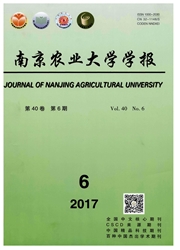

 中文摘要:
中文摘要:
基于GenBank中根结线虫属的核酸序列,筛选了28S(D2/D3)、18S和ITS3个不同的序列片段,利用遗传距离法和分子系统学方法评价其各自作为根结线虫条形码标记的可行性。结果显示:28S(D2/D3)、18S及ITS的核酸序列种内平均遗传距离分别为0.0043、0.0027和0.024,种间平均遗传距离分别为0.074、0.036和0.156,由于属内近缘种的影响,各分子标记的种内、种间遗传距离均有一定的重叠;基于K2P模型构建的3种分子标记NJ系统发育树显示,南方根结线虫、爪哇根结线虫、花生根结线虫均混合聚类,难以区分;经统计,28S(D2/D3)、18S及ITS对根结线虫属内不同种的识别率分别为74%、60%和46%。研究表明:28S(D2/D3)具有一定的遗传距离问隔以及相对较高的物种识别率,可以作为根结线虫属候选条形码标记。
 英文摘要:
英文摘要:
In order to evaluate the feasibility of 28S (D2/D3), 18S and ITS loci as candidate DNA barcode markers for root-knot nematodes ( Meloidogyne spp. ), the nucleotide sequences retrieved from GenBank were analysed using pair-wise distance and phylogenetic methods. The results revealed that the average intraspecific divergences of 28S (D2/D3) , 18S and ITS are 0. 004 3, 0. 002 7 and 0. 024, respectively; for interspecific, are 0. 074,0. 036 and 0. 156, respectively. The genetic distances between intraspecific and interspecific of 3 loci showed some overlapping due to the existence of close sibling species of Meloidogyne. The neighbour-joining trees of sequences from 3 loci constructed by K2P model demonstrated that M. incognita, M. javanica and M. arenaria were mixed grouping and difficult to be separated each other into one branch. The loci of 28S( D2/D3 ), 18S and ITS resolved 74% ,60% and 46% of the Meloidogyne species we tested, respectively. In overall, the 28S (D2/D3)locus was evaluated as a candidate barcode marker for Meloidogyne spp. due to its larger barcoding gap and higher species resolution.
 同期刊论文项目
同期刊论文项目
 同项目期刊论文
同项目期刊论文
 期刊信息
期刊信息
